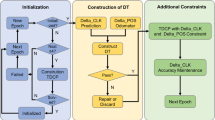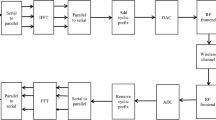Abstract
Multiple Path Interference (MPI) and Multiple Access Interference (MAI) are important factors that affect the performance of Chinese Area Positioning System (CAPS). These problems can be solved by using spreading sequences with ideal properties and multi-user detectors. Chaotic sequences based on Chebyshev map are studied and the satellite communication system model is set up to investigate the application of chaotic sequences for CAPS in this paper. Simulation results show that chaotic sequences have desirable correlation properties and it is easy to generate a large number of chaotic sequences with good security. It has great practical value to apply chaotic sequences to CAPS together with multi-user detecting technology and the system performance can be improved greatly.
Similar content being viewed by others
References
Ai G X, Shi H L, Wu H T, et al. Satellite communication and positioning system. PRC Patent, 200410046064.1, 2004-06-03
Shang J N, Shi H L, Lu X C, et al. Communication and positioning system based on time, position and status. PRC Patent, 200610012056.4, 2006-05-31
Pratt T, Bostian C, Allnutt J, et al. Satellite Communications. 2nd ed. Beijing: Publishing House of Electronics Industry, 2003
Ai G X, Shi H L, Wu H T, et al. A positioning system based on communication satellites and the Chinese Area Positioning System (CAPS). Chin J Astron Astrophys, 2008, 8(6): 611–630
Ai G X, Shi H L, Wu H T, et al. The principal of the positioning system based on communication satellites. Sci China Ser G-Phys Mech Astron, 2009, 52(3): 472–488
Ning C L, Shi H L, Hu C. GPS/CAPS dual-mode software receiver. Sci China Ser G-Phys Mech Astron, 2009, 52(3): 360–367
Hu Y H, Hua Y, Hou L, et al. Design and implementation of the CAPS receiver. Sci China Ser G-Phys Mech Astron, 2009, 52(3): 445–457
Schneider K S. Optimum detection of code division multiplexed signals. IEEE Trans. Aerosp Electron Syst, 1979, 15(1): 181–185
Kohno R, Hattori M, Imai H, et al. Cancellation techniques of co-channel interference in asynchronous spread spectrum multiple access systems. Electr Commun Jpn, 1983, 66(5): 20–29
Wei H M, Zhang B N. Chaotic spread spectrum communication technology and application (in Chinese). Xi’an: Xidian University Press, 2007
Glisic S, Vucetic B. Spread spectrum CDMA systems for wireless communications (Mobile Communications Series). London: Artech House Publishers, 1997
Kohda T, Tsuneda A. Pseudo-noise sequences by chaotic nonlinear maps and their correlation properties. IEICE Trans Commun, 1993, E76-B(8): 855–862
Vitali S, Rovatti R, Setti G. On the performance of chaos-based multi-code DS-CDMA systems. Circuits Syst Signal Process, 2005, 24(5): 475–495
Nan M K, Shi X Q, Zeng J F. A synchronization scheme for chaotic direct spreading sequence immune of quantization errors (in Chinese). J Commun, 2000, 21(9): 62–65
Wang H, Hu J D. Chaotic sequences based on Logistic-Map (in Chinese). Chin J Electron, 1997, 25(1): 19–23
Wang H, Hu J D. Modified logistic-map chaotic spread-spectrum sequences (in Chinese). J Commun, 1997, 18(8): 71–77
Feng J C, Yu Y L, Zhou S. Spread-spectrum communication based on chaos (in Chinese). J Commun, 1998, 19(6): 76–83
Kostov N. Mobile radio channels modeling in MATLAB. Radio Eng, 2003, 12(4): 12–16
Yahong R, Xiao C S. Improved models for the generation of multiple uncorrelated Rayleigh fading waveforms. IEEE Commun Lett, 2002, 6(6): 256–258
Xiao C S, Yahong R, Beaulien N C. Second-order statistical properties of the WSS Jakes’fading channel simulator. IEEE Trans Commun, 2002, 50(6): 888–891
Shao S X, Yang L X. Blind adaptive multi-user detector for nonlinearly modulated satellite mobile CDMA systems. J Electron, 2006, 23(3): 338–340
Honig M, Madhow U, Verdu S. Blind adaptive multi-user detection. IEEE Trans Inform Theory, 1995, 41(4): 944–960
Zhang X D, Wei W. Blind adaptive multi-user detection based on kalman filtering. IEEE Trans Signal Process, 2002, 50(1): 87–95
Zheng J L, Zhang Q. Choice of chaotic spreading sequences for asynchronous DS-CDMA communication (in Chinese). Chin J Electron, 2001, 29(7): 865–867
Author information
Authors and Affiliations
Corresponding author
Additional information
Supported by the National Basic Research Program of China (Grant No. 2007CB815500) and the National High Technology Research and Development Program of China (Grant No. 2007AA12z343)
Rights and permissions
About this article
Cite this article
Lei, L., Shi, H. & Ma, G. CAPS satellite spread spectrum communication blind multi-user detecting system based on chaotic sequences. Sci. China Ser. G-Phys. Mech. Astron. 52, 339–345 (2009). https://doi.org/10.1007/s11433-009-0050-0
Received:
Accepted:
Published:
Issue Date:
DOI: https://doi.org/10.1007/s11433-009-0050-0




